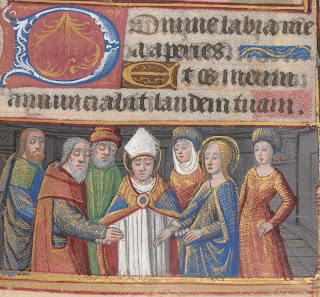As you might expect, there are many, many medieval depictions of St Joseph at various points throughout his life. Chronologically speaking, he first appears at his marriage to Mary, shown here in a fifteenth-century French Book of Hours (Yates Thompson 3, f. 37):
The story of Mary and Joseph's marriage is not in the Gospels, but there are abundant apocryphal tales about it - wikipedia summarises them nicely. The choice of Joseph as Mary's husband came about in this way: the law said that when Mary reached the age of 14 she had to marry, so the high priest gathered together the male descendants of King David and had them bring rods to the temple. If one of their rods miraculously burst into flower, that man would be Mary's chosen husband. And so it happened - I think you can see a flowering rod in Joseph's hand in the picture above (the original is very small, so it's not entirely clear).
The marriage of Mary and Joseph forms part of the mystery play cycles, one example of which you can read here - it's utterly delightful. As this story tells it, neither Mary nor Joseph wants to get married at all - Mary having committed herself to virginity, and Joseph believing himself too old - but Mary agrees to submit to the law, and Joseph is badgered by his relatives into bringing his rod to the temple, complaining all the way about how old and feeble he is. When the priest declares the miracle of the blossoming rod, Joseph is not impressed:
EPISCOPUS Ah, gracious God in heaven's throne,
Right wonderful thy works be!
Here may we see a marvel one —
A dead stock beareth flowers free!
Joseph, in heart without moan,
Thou mayst be blithe with game and glee!
A maid to wed thou must gone [take]
By this miracle I do well see —
Mary is her name.
JOSEPH What, should I wed? God forbid!
I am an old man, so God me speed!
And with a wife now to live in dread,
It were neither sport nor game.
EPISCOPUS Against God, Joseph, thou mayst not strive!
God wills that thou a wife shouldst have.
This fair maid shall be thy wife —
She is buxum and white as lave. [humble and white as bread]
JOSEPH Ah, should I have her? Ye destroy my life!
Alas, dear God, should I now rave?
An old man may never thrive
With a young wife, so God me save!
Nay, nay, sir, let be!
Should I now in age begin to dote?
If I her chide, she would clout my cote,
Blear my eye and pick out a mote, [nag at me]
And thus oftentimes it is seen.
EPISCOPUS Joseph, now as I thee say,
God hath assigned her to thee.
What God will have done, say thou not nay!
Our Lord God wills that it so be.
JOSEPH Against my God not do I may.
The old man/young wife thing is a common source of humour in medieval literature (think of the Miller's Tale!). Having agreed to it, Joseph and Mary are wedded - with vows whose language you may recognise:
EPISCOPUS Say then after me: “Here I take thee, Mary, to wife;
To have, to hold, as God his will with us will make;
And as long as between us lasteth our life,
To love you as myself, my troth I you betake.”
Mary, will ye have this man,
And him to keep as your life?
MARIA In the tenderest wise, father, as I can,
And with all my wits five.
EPISCOPUS Joseph, with this ring now wed thy wife,
And by her hand now thou her take.
JOSEPH Sir, with this ring, I wed her ryff [at once]
And take here now her for my make. [mate]
Having taken Mary 'to have and to hold', Joseph finds a 'little pretty house' for them to live in. We all know what happened next; and here's Joseph thinking it all over:
'Marvel not, Joseph, at Mary mild;
Forsake her not, though she be with child...'
Moving on to Nativity scenes, of which there are of course a huge number, here are two of my favourites: first, Joseph adjusting Mary's pillow (Royal 1 D X, f.1v):
And here with an impressive beard, not daunted by the doe-eyed fauna above him (Harley 928, f.3v):
Then another angel tells Joseph to flee into Egypt (Yates Thompson 13, f.95):
Here, both angel and flight are shown in one swift scene (Harley 7026, f.7):
Here, Joseph takes off his night-cap and picks up a bundle (Lansdowne 420, f.9):
There are 'Flight into Egypt' traditional carols too, based on the Infancy narratives - here's a good one, where Herod's men are thwarted by Christ miraculously making a farmer's crop to ripen on the day it was sown, so that the farmer can honestly tell the pursuers "He passed this way when my seeds were being sown!". Herod's men think that must have been at least three quarters of a year ago, and so give up the pursuit. A handy trick.
Later, Joseph appears in scenes of the Presentation in the Temple, usually carrying his bag of three little birds, and often a candle too (Stowe 12, f.242v):
With a hat, gargoyles and a particularly realistic baby Christ (Royal 2 B VII):
And to close with another from the same manuscript, here an aged Joseph and Mary watch in apprehension as the child Christ, mounted on a little stool, disputes with the doctors in the Temple:
Poor St Joseph; his was not an easy task...












No comments:
Post a Comment